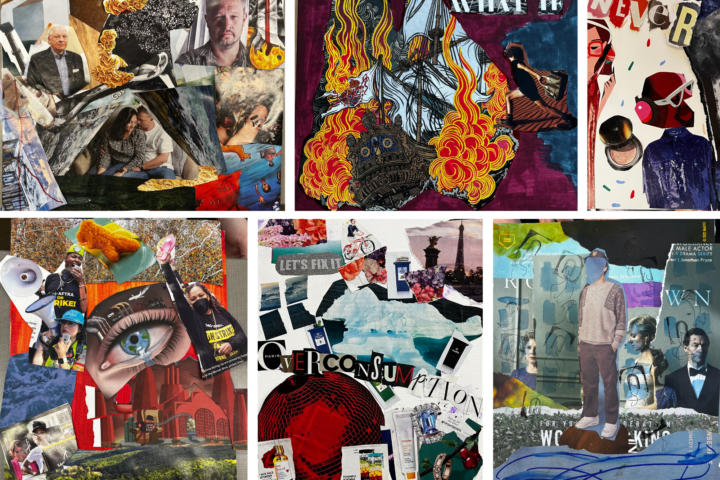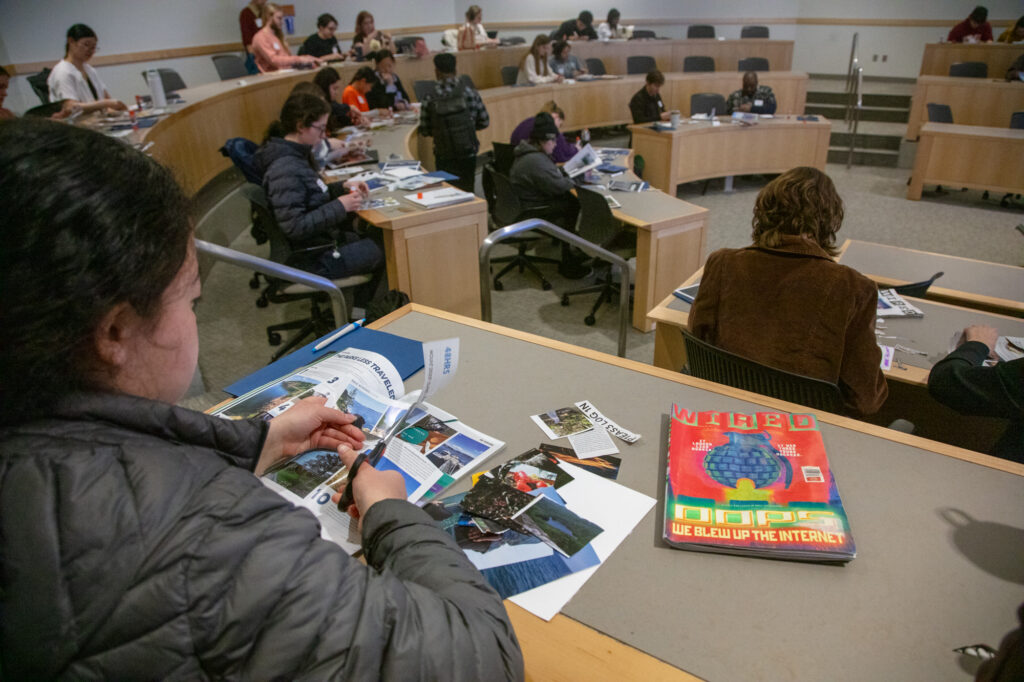
Artivism in Action: Empowering Youth Through Collage
April 29, 2024By Susan Tang, Program Manager
Col·lage [kəˈläZH] n., v. – a technique of art creation, primarily used in the visual arts, but in music too, by which art results from an assemblage of different forms, thus creating a new whole
One of my favorite parts of being at Bow Seat is working directly with youth to get them thinking about the environment through the lens of creative advocacy. And luckily for me, the warmer spring weather brings with it a slew of events and conferences where I get to do just that! Over the past month, I’ve had the opportunity to design and facilitate workshops and activities for hundreds of students all over New England. Meeting youth from all walks of life – including those who don’t have any particular interest in the environment or art – has left me feeling re-energized about the work that I do and hopeful for the future of our planet.

I start my workshops with an overview of activist art (also known as artistic activism, or “artivism”), that is, the utilization and mobilization of art for political, creative, and social change or transformation. I walk workshop participants through several historic examples of activist art and the social movements that birthed them, from Paul Revere’s (in)famous engraving “The Boston Massacre” (1770) that helped spark the American Revolution to Albert Staehle’s “Smokey Bear” (1944), an enduring symbol of environmental stewardship and consciousness. I go on to introduce participants to Bow Seat and our 2024 Contest theme, Tell Your Climate Story, before giving students the opportunity to reflect on their own climate stories and become “artivists” themselves by making collages!
Students are asked to reflect on prompts like “What does the climate crisis look like to you?”, “When you think about climate change, what emotions come up?”, “How has climate change impacted you? Your community?” and “What is bringing you hope for the future of our planet?”. Volunteers help me pass out magazines (foraged from friends and neighbors), canvases, scissors, glue sticks, stamps, scrap fabric, stencils, markers, sheet music – the stuff of any crafter’s dreams. I’ll put on my “Artivism” playlist – a collection of my favorite songs generating awareness/visibility around key issues and calling for/imagining a better world – to get those creative juices flowing and loosen up the atmosphere. And I’ll let the students have at it!

I love asking students to walk me through their creative vision or design process. Some will jump at the chance to explain exactly how their use of color or imagery evokes complex themes of overconsumption, environmental degradation, the current political climate, etc. Others will tell me they have no idea what they’re doing – that they don’t have an artistic bone in their body. So I’ll laugh and tell them that that’s the great thing about collaging: the art’s all pre-made! All you have to do is put everything together! And as long as you fill up all the blank space in your canvas, you can’t go wrong.
In this way, collaging is one of the most accessible forms of art-making for the self-prescribed non-artist. A blank canvas can be really intimidating for those who haven’t had many opportunities to be creative – maybe due to a lack of materials, or a lack of time, or the fear that what they create isn’t good enough. The hodge-podge, “anything goes” nature of collaging allows it to overcome some of these barriers to entry that can plague the world of art. And with a little bit of encouragement (and nothing else to do for the next 25 minutes), any student can create a masterpiece. It’s just about giving them the space, resources, and support to do so. I feel so fortunate to have been able to provide that for the students I’ve gotten to work with.

I’ve never really thought of myself as a role model before. I’m less than a year out of college and still learning how to navigate the world, trying my best to do work that feels good. And yet – after one of my workshops, a student called me “literally the coolest person ever” with an earnestness that warmed my heart. At another event, a student approached me after hearing me speak on the day’s keynote panel and shyly asked me what it was like being a queer person in STEM. Interactions like this mean the world to me. They reinforce how important it is for students of marginalized identities to feel represented and welcomed in spaces they have historically been excluded from. I can’t believe I get to be someone who holds the proverbial door open for a new generation of environmental advocates. Even if I never see these students again, I am so glad and so grateful to have had the chance to connect and create with them!

